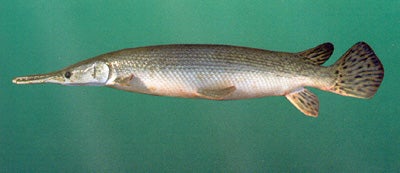SCIENTIFIC NAME:
Atractosteus spatula
CHARACTERISTICS:
Alligator gars typically have from 57 to 62 lateral line scales and 23 diagonal scale rows between the anal fin origin and the dorsal midline. Adult gars always have two rows of teeth in the upper jaw, compared to one row in all other gar species. Younger individuals may have only one row. The back and sides of this species are green to gray, and the venter is white. The vertical fins are tan with varying numbers of round black spots.
ADULT SIZE:
5.9 to 9.8 ft (1.8 to 3 m).
STATE RECORD:
a list of the State Record Freshwater Fish.
DISTRIBUTION:
Alligator gars still inhabit the Mobile Delta and adjacent coastal waters, but recent reports indicate that inland occurrences are rare. One author (MFM) remembers that in the 1950s the Demopolis Times featured a photograph of a large alligator gar caught in either the Tombigbee or the Black Warrior River. A 140-pound specimen was caught in the Alabama River near Claiborne Ferry in Monroe County on 5 July 1928 (John Hall, 1992, personal communication). In November 1991, we examined two alligator gars taken with bow and arrow in Chuckfee Bay north of the Mobile Causeway. One weighed 100 pounds, the other 120. Personal encounters with this species are limited to collections of several smaller individuals (18 to 30 inches total length) in the Mobile Delta and three larger specimens (45 to 50 inches total length) from the Conecuh River near Brewton. We have also examined photographs of several individuals collected with hook and line in Dog River, Fish River, and the Mobile Delta.
HABITAT AND BIOLOGY:
Alligator gars live in Alabama’s coastal estuaries as well as in its major rivers and large streams. The Conecuh River sites where we collected this species were characterized by a moderate current and predominantly sand and gravel substrates. Mobile Delta collections were from brackish water near Mobile Bay, where currents were slow and substrates were composed mainly of silt and mud. As with other gar species, spawning probably occurs in the spring.
ORIGINAL DESCRIPTION:
Lacepede described the alligator gar in 1803.
ETYMOLOGY:
Atractosteus from the Greek words atractus meaning spindle and osteos meaning bony. (The former genus used in Fishes of Alabama and the Mobile Basin, Lepisosteus, means bony scale.)
Spatula means spatula, referring to the shape of the snout.
The copyrighted information above is from Fishes of Alabama and the Mobile Basin, except for the updated state record information.






